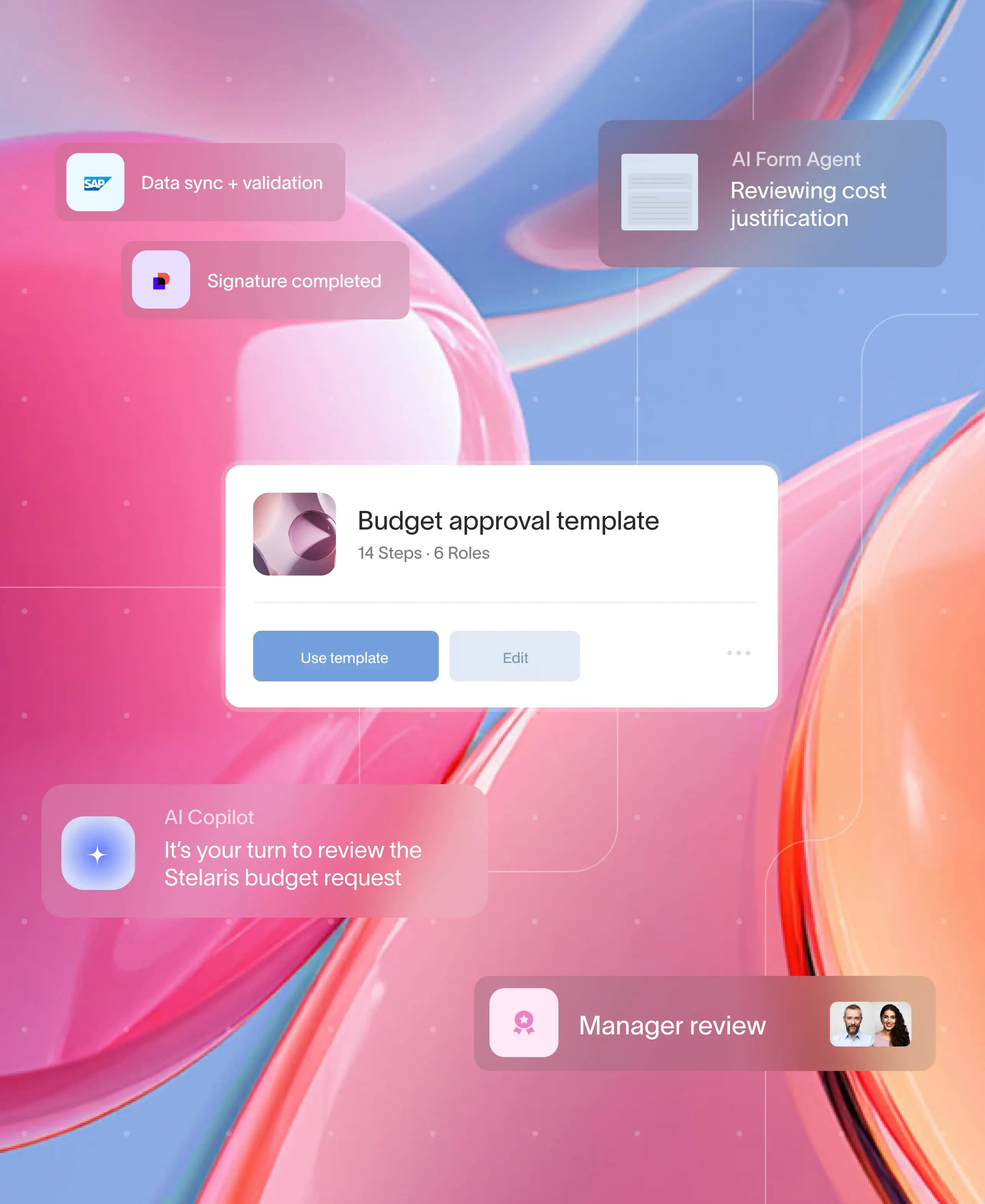
As organizations scale, so does operational complexity. Without defined workflows, businesses face delays, miscommunication, and duplicated efforts that reduce efficiency and impact profitability. Business process design emerges as a solution to improve business efficiency.
Business process design is a systematic way to create and improve workflows that define how tasks, responsibilities, and information flow across teams. It is not about drawing diagrams. It is about orchestrating processes that are intuitive, measurable, and aligned with business goals. When done right, business process design enables teams to move faster, collaborate better, and adapt to change without chaos.
Businesses today need intentional, repeatable systems that are scalable. Whether you’re a professional services firm streamlining client onboarding or a financial organization refining approval flows, designing an effective process is the foundation for sustainable growth.
This guide will walk through the business process design methodology, offer real-world examples, and show how platforms like Moxo can streamline the entire workflow.
5 things to consider before designing a business process
Designing a business process is about making decisions that affect how teams work, how systems communicate, and how results are delivered. Before jumping into workflows, there are foundational elements that must be considered to ensure the process is purposeful and scalable.
Understand the business objective
Every business process should tie back to a clear business goal. Whether it's reducing turnaround time, improving customer onboarding, or ensuring compliance, defining the purpose upfront ensures the workflow stays focused and aligned.
Identify key stakeholders
Include the right voices from the point you start designing the business processes. Stakeholders may include department leads, frontline users, clients, or compliance officers. Their input ensures the process designed addresses real-world needs and challenges.
Map the current state
If a version of the process already exists, analyze it before redesigning. Look for bottlenecks, duplicated tasks, and missed handoffs. This insight helps highlight where improvements can create the most impact.
Consider regulatory or operational constraints
Industries like finance, healthcare, or legal processes must adhere to strict regulations. These boundaries need to be factored in early to avoid redesigning later for compliance.
Plan for scalability
A well-designed process should work for the future. Think beyond your current team size or task volume. A scalable design accommodates growth without requiring a complete overhaul.
With these considerations in place, you're ready to move into the design phase. This is where goals, roles, and actions are translated into a structured, repeatable system.
Business process design: A step-by-step approach
Once the foundation is set, it’s time to turn strategy into structure. A thoughtful business process design approach ensures consistency, minimizes risk, and builds a framework for continuous improvement. Here are the key steps in the process:
1. Define the purpose and scope
Start by establishing the goal of the process/workflow. What outcome should it deliver? Define the scope by identifying where the process starts, where it ends, and what it includes. This sets out clear expectations.
2. Gather input from stakeholders
Consult team members who will use, manage, or be affected by the process. This helps you surface important use cases, pain points, and context that might otherwise be overlooked.
3. Outline tasks and decision points
List every action that needs to occur to move the process forward, including conditional steps. Identify task owners, required approvals, dependencies, and decision points. The goal is to make the flow executable without ambiguity.
4. Map the process flow
Use visual mapping to lay out the process sequence. This creates a shared understanding across teams and helps reveal gaps, redundancies, or steps that can be automated. Tools like flowcharts or digital process builders can bring this to life.
5. Test with a pilot run
Before full rollout, test the process with a small team or single client. Collect feedback on what works and what creates friction. This phase allows you to make necessary refinements before the process scales.
6. Implement and monitor
Deploy the process and monitor performance using KPIs like cycle time, task completion rate, or satisfaction scores. This ensures that the process continues to deliver value.
7. Optimize continuously
As businesses evolve, processes should evolve with them. Set a review cadence to identify new bottlenecks or opportunities for automation. Ongoing improvements lead to long-term efficiency gains.
Following this methodology to design business processes ensures workflows are well-planned and responsive to real-world conditions.
Business process design: Examples in action
Seeing how process design works in practice can help bring abstract steps into focus. Below are a few business process design examples that show how structured workflows can be applied across different industries and departments.
Client onboarding workflow
Industry: Professional services
Overview: When a new client is signed, the onboarding process involves sending a welcome message, collecting documentation, setting up accounts, and assigning internal ownership. A well-designed client onboarding business process ensures no steps are skipped and clients experience a consistent introduction.
Invoice approval process
Industry: Finance and accounting
Overview: This business process routes invoices from the receiving team to finance for validation, then to a manager for approval, and finally to payment. Using automation reduces approval delays and ensures audit readiness.
Contract review and approval
Industry: Legal and compliance
Overview: A workflow for legal teams might route a draft contract through risk assessment, redlining, internal approval, and client sign-off. Process design ensures compliance checkpoints are not overlooked.
Each of these examples reflects how intentional business process design improves clarity, accountability, and efficiency. These workflows also lay the groundwork for automation—something Moxo helps teams scale across departments.
How do efficient workflows fuel business growth
Efficient workflows are growth enablers. When a business process is clearly defined and well-executed, it drives consistency, eliminates unnecessary steps, and improves how teams collaborate. These benefits compound over time, creating long-term value across the organization.
- Faster turnaround and better client experience: When workflows are efficient, teams spend less time managing tasks manually. That means faster response times, fewer delays, and better experiences for clients and partners.
- Reduced errors and rework: Clarity in task ownership and sequence helps reduce handoff confusion and manual mistakes. This lowers operational risk and allows staff to focus on quality work instead of fixing preventable issues.
- Improved decision-making: Standardized workflows generate reliable data. This gives leadership clearer visibility into performance, helping them make faster, informed decisions about resource allocation, process changes, or client management.
- More time for strategic work: When repetitive coordination is removed, teams can refocus on high-value initiatives like product innovation, client strategy, or expansion planning.
Ultimately, business process design is about creating a system that allows the business to scale with less friction.
How does Moxo streamline and automate business processes
Moxo is a service orchestration platform that enables businesses to design, automate, and execute workflows that span internal teams and external clients. It eliminates the friction that often slows down operations by providing a structured, secure environment for collaboration.
From design to execution
Moxo enables teams to build standardized, repeatable workflows that mirror real-world operations. Whether it’s client onboarding, document review, or approvals, businesses can map out steps, assign roles, and track outcomes without relying on manual coordination.
Automation where it matters
With Moxo, non-value-added tasks like follow-ups, document requests, and status notifications can be automated across every stage of the workflow. This reduces time spent on administrative work and ensures nothing falls through the cracks.
Integration with existing systems
Moxo integrates with CRM, cloud storage, and other business platforms to keep data flowing smoothly. External systems can automatically trigger Moxo workflows to ensure processes start at the right time with the right context.
Unified client experience
Moxo creates a shared environment for clients and teams to interact in real-time. From secure messaging to file exchange and task management, Moxo simplifies every touchpoint in the process.
Transform your business process design strategy into a scalable, streamlined system with Moxo – without the complexity. Easily build and automate workflows that grow with your business. Get started today.
Conclusion
Business process design is a strategic decision that shapes how work gets done across your organization. From reducing delays to improving collaboration and client satisfaction, a well-designed process unlocks greater efficiency and long-term scalability.
The ability to define, automate, and continuously improve processes is essential when managing client processes. Platforms like Moxo bring this vision to life. By streamlining coordination, enabling automation, and integrating with existing systems, Moxo empowers businesses to move faster, stay aligned, and focus on what drives value. Take the first step towards smarter business process design - Get started now!
FAQs
What is business process design?
Business process design is a systematic way to create and improve workflows that define how tasks, responsibilities, and information flow across teams. It involves mapping out workflows, identifying responsibilities, and optimizing steps to increase efficiency and consistency.
What are the core business process design steps?
The steps to design business processes include defining goals, gathering stakeholder input, outlining tasks, mapping the process visually, testing with a pilot run, launching, and continuously optimizing.
How do you design a process that scales with the business?
Start by aligning the process with business objectives, then define each step clearly, assign task ownership, and build flexibility for future growth. Using a service orchestration platform like Moxo supports both scale and adaptability.
What role does technology play in process design?
Technology streamlines the design, execution, and monitoring of workflows. Platforms like Moxo offer built-in automation, task routing, and integrations that reduce manual work and improve visibility.
Why does business process design matter for growing companies?
As operations expand, ad hoc processes break down. Business process design brings structure, accountability, and consistency to workflows, thereby laying the foundation for sustainable growth.





